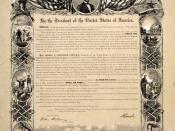SlaveryÃÂs Impact on Raleigh, North CarolinaSlavery during the 19th and 20th centuries varied greatly from region to region and even from one slave owner to the next. Although most people have at least a basic understanding of what slavery was like during this era, most are unaware of the fear and brutality that many slaves had to live and deal with on a daily basis. By hearing and reading first-hand accounts from former slaves, one is able to have a much deeper understanding of the lifestyle that a slave in a particular region had, as well as an understanding of the impact that slaveÃÂs labor had on the region. Clay Bobbit, a former slave, recounts his life growing up as a slave in Raleigh, North Carolina. Mr. BobbitÃÂs story, with some added research, gives a very detailed description of the life of a typical slave in the piedmont region of North Carolina in the 19th and 20th centuries.
Most slaves in the piedmont region of North Carolina worked in tobacco or cotton fields (Boyken 15). In the 1860s, approximately 25-50% of the total population of Raleigh was slaves (Powell, ÃÂEncyclopediaÃÂ 45). The cotton industry was literally blooming in the late 1800s, and from 1860 to 1880, the number of bales of cotton produced in the piedmont region of North Carolina had nearly tippled, reaching almost 400 thousand bales. The amount of tobacco had increased drastically as well, and in 1880, 27 million pounds of tobacco were produced (Powell, ÃÂFour CenturiesÃÂ 52). With the large amount of cotton and tobacco being produced, slave labor was seen as a necessity. Despite the piedmont regions large output of agriculture, however, very few plantations had a large amount of slaves; only one farmer out of every fifty had over twenty slaves working for them...


